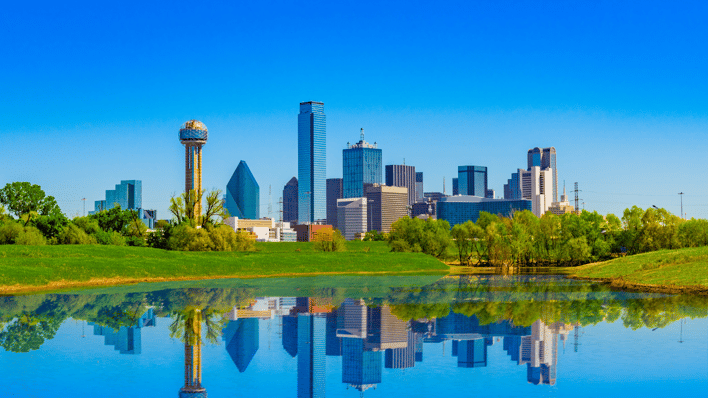Dallas Housing Market in 2025: Buyers Are Back in the Driver’s Seat
 Author: Michael Bernstein
Author: Michael BernsteinPublished:
After years of soaring prices, bidding wars, and pandemic-fueled chaos, the Dallas housing market in 2025 has finally found its balance—and that’s good news for homebuyers. Inventory is up, sellers are offering concessions, and while prices have largely stabilized, many listings are lingering longer on the market.
At LendFriend Mortgage, we’ve helped hundreds of Dallas-area buyers through the highs and lows of the past five years. Today, we see the return of something the market hasn’t offered in a while: negotiating power. If you’re a buyer with a plan and a preapproval in hand, this is your moment to get a deal in Dallas.

Dallas’ History at a Glance: From Rail Hub to Innovation Center
Dallas’s rise began with geography. In the 19th century, it wasn’t oil or cattle that first put the city on the map—it was the railroads. Situated at the intersection of major routes connecting the Gulf Coast, the western frontier, and the Midwest, Dallas quickly became a central trading and distribution hub for goods moving across Texas and beyond. By the early 1900s, this strategic location had transformed it into one of the Southwest’s most important economic centers.
The city’s next evolution came in the mid-20th century, when Dallas began attracting financial institutions and telecom giants. Companies like Texas Instruments, founded in 1930 as Geophysical Service Inc., helped establish the city as a global leader in electronics and semiconductors. Later, Dallas became one of the birthplaces of the telecommunications industry, thanks to Southwestern Bell and AT&T—both of which maintained major presences in the region.
Today, Dallas ranks among the top metros in the country for Fortune 500 headquarters. It’s home to corporate giants across a range of industries: telecommunications (AT&T), semiconductors (Texas Instruments), commercial real estate (CBRE Group), aviation (Southwest Airlines), architecture and engineering (Jacobs Engineering), and energy (Energy Transfer and HF Sinclair). Toyota North America and McKesson have also relocated their U.S. headquarters to the Dallas-Fort Worth area in recent years. This diversity of employers has given Dallas rare economic insulation—when one industry dips, others tend to hold steady or grow.
How COVID Changed Dallas Real Estate
When COVID-19 hit in early 2020, the Dallas housing market was already on a steady upward climb. But the pandemic turbocharged that growth. Lockdowns and remote work trends caused a rapid shift in where—and how—people wanted to live. Suddenly, the appeal of larger homes, extra bedrooms, and outdoor space sent demand soaring in the suburbs of Dallas-Fort Worth. Areas like Frisco, McKinney, and Prosper saw home prices jump by 30% to 50% between 2020 and 2022, while city neighborhoods like East Dallas and Oak Cliff also experienced bidding wars.
The low-rate environment during the pandemic played a massive role. With mortgage rates dropping below 3% for much of 2020 and 2021, buyers could afford more house for the same monthly payment. This dynamic, paired with a national migration toward Texas, created one of the tightest seller’s markets in Dallas history. Inventory fell to record lows—often below one month’s supply—and homes regularly sold within days, sometimes with dozens of offers and no contingencies.
But that story shifted dramatically in 2022 when inflation concerns prompted the Federal Reserve to hike interest rates. As mortgage rates rose from the low 3s to the high 6s and 7s, buyer affordability eroded almost overnight. Demand cooled, and homes that would have flown off the market in 24 hours now sat for weeks. By 2023, the share of homes selling above list price had dropped sharply. Redfin reported that nearly two-thirds of Dallas homes sold below asking in 2024—a clear sign of a market correction.
The good news is that Dallas didn’t crash. Home values moderated rather than plummeted, buoyed by strong local job growth and persistent in-migration. Unlike some other metros that became overextended during the pandemic, Dallas maintained a steady stream of buyers moving in from California, Illinois, and the East Coast. These buyers, often flush with equity from higher-priced markets, helped prop up home values even as local affordability took a hit.
By mid-2025, the market has found its footing. Inventory is up—by over 30% year-over-year—but demand is still present, just more rational. The typical home now sits on the market for around 38 days, compared to 10–14 days during the pandemic peak - but 38 days is still better than other cities like Austin and Houston. Price appreciation has returned, but at a more sustainable pace, with median values climbing just under 6% this year. It’s a reset—not a retreat.
Why Dallas Shows Signs of Long-Term Strength
Despite recent market volatility, the fundamentals in Dallas—and the broader DFW region—remain incredibly strong:
✅ A Growing, Young Population
Dallas-Fort Worth added 170,000 new residents in 2023 alone, and the metro area is on pace to reach 10 million people by 2035. Growth fuels demand, and demand supports prices—especially in affordable job centers like Dallas.
✅ Record Job Growth
According to a June 2025 DFW Jobs Report, the area added 128,000 jobs year-over-year, with professional services and construction leading the way. Employment growth remains one of the strongest housing tailwinds.
✅ Affordability vs. National Peers
- Dallas: ~$467,500
- Austin: ~$538,000
- Los Angeles: $750,000+
For remote workers, first-time buyers, or families relocating from high-cost metros, Dallas continues to offer a compelling value proposition—especially in the inner-ring suburbs and southern sectors of the city where prices are lower but infrastructure is improving.
Plus Fast-Growing Cities Are Expanding the DFW Opportunity
One of the most powerful trends shaping Dallas’s long-term outlook isn’t just what’s happening in the city—it’s what’s happening around it.
North of Dallas, small towns have rapidly evolved into destination suburbs. Celina, once a rural outpost, is now the fastest-growing city in North Texas, with master-planned communities, new schools, and high-end retail drawing in thousands of new residents annually. Frisco, just south of Celina, has become a national model for suburban development, thanks in part to the arrival of the PGA of America headquarters, which includes a championship golf course, resort, and a $500 million mixed-use district.
Meanwhile, Universal Studios is building a first-of-its-kind theme park in Frisco, designed specifically for young families and day-trippers. It’s expected to draw over 2 million annual visitors once completed—bringing new infrastructure, jobs, and sustained commercial growth with it.
Further west, cities like Prosper, Little Elm, and Northlake are following similar paths—attracting developers, employers, and new residents at record pace. These communities are helping relieve affordability pressures in the urban core while offering upgraded amenities and highly rated schools.
And They’re A City That Invests in Itself
Dallas isn’t just growing—it’s modernizing. Over the past few years, the city has launched major infrastructure, public space, and transit upgrades aimed at long-term livability and economic competitiveness. Projects like the Southern Gateway Deck Park, the Kay Bailey Hutchison Convention Center expansion, and Main Street Core revitalization are transforming underutilized spaces into vibrant, accessible hubs.
DART continues to expand light rail and rapid bus access across the city and into the suburbs, while developers are building mixed-use communities around new transit stations to meet demand for walkable, urban lifestyles. The city is also making targeted investments in underserved neighborhoods, including Fair Park, Redbird, and the West Dallas corridor—places where new jobs, retail, and housing are arriving all at once.
Meanwhile, the region’s northern suburbs are building large-scale entertainment, education, and commercial centers—like the Universal Studios theme park in Frisco—that promise long-term population and job growth far beyond Dallas’s core.
How can buyer’s take advantage of this market?
Mortgage rates have stayed between 6% and 7% through early 2025. With greater inventory, softened pricing, and more room to negotiate, the monthly payment math is more manageable than you might expect. Many buyers are getting their seller to fund 2-1 temporary buydowns AND provide additional seller credits so buyers are able to achieve lower rates and minimal closing costs.
At LendFriend, we’re helping buyers lock in today’s opportunities—and build a refinance strategy for tomorrow (with our Rate Rebound Program), when rates are expected to gradually trend downward again.
The Bottom Line: 2025 Is About Timing and Leverage
We’re not in a crash—and we’re no longer in a frenzy. Dallas is in a window of opportunity where informed buyers can make strong offers, secure financing, and lock in long-term value. With steady job growth, diverse industry support, rapid suburban expansion, and citywide reinvestment, Dallas remains one of the most promising real estate markets in the country.
If you’re ready to explore your options, we’re here to help. Whether you need loan guidance, want to understand what you qualify for, or need a trusted agent referral, the LendFriend team is ready to walk you through the process—without pressure.
If you want to discuss your loan options and learn how to buy in 2025, give us a call at 512.881.5099 or get in touch with me by completing this quick form, and I'll be in touch as soon as possible.

About the Author:
Michael Bernstein